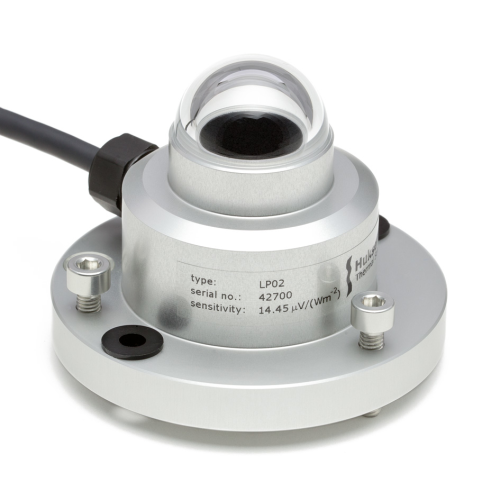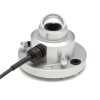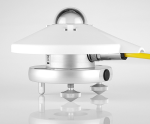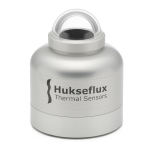This product is no longer available and has been replaced by: SR05-L.

| 利用できるサービス | |
|---|---|
| 修理 | 対応 |
| キャリブレーション | 対応 |
| フリーサポート | 対応 |
概要
The LP02, manufactured by Hukseflux, is an ISO 9060:2018 spectrally flat Class C (second class) pyranometer that monitors solar radiation for the full solar spectrum range. It produces a millivolt signal that is measured directly by a Campbell Scientific data logger. The LP02 can provide solar radiation measurements for a variety of meteorological applications.
続きを読む利点と特徴
- Compatible with most Campbell Scientific data loggers
- Measures reflected solar radiation when inverted
- Provides measurements in direct sunlight, under plant canopies, when the sky is cloudy, and in artificial light
- Includes bubble level and leveling screws, eliminating the need for a separate leveling base and simplifying installation
- Acceptable for providing the solar radiation data used in stability estimations
- Dome protects thermopile and allows water to roll off of it
- Designed for continuous indoor and outdoor use
イメージ



詳細
The LP02 measures solar radiation with a high-quality blackened thermopile protected by a dome. The blackened thermopile provides a flat spectral response for the full solar spectrum range, which enables the LP02 to be used under plant canopies or lamps, when the sky is cloudy, and for reflected radiation measurements.
The LP02 includes a bubble level, three adjusting screws, and a cable gland. The bubble level and adjusting screws allow the sensor to be leveled without using a leveling base. The gland facilitates cable replacement.
The LP02 produces a millivolt signal that is measured directly by a Campbell Scientific data logger.
Two LP02 pyranometers can be mounted back-to-back to make a low-cost albedometer. Contact Campbell Scientific for more information.
Because the LP02 is a second-class pyranometer, it is acceptable for providing the solar radiation data used in stability estimations (EPA Meteorological Monitoring Guidance for Regulatory Modeling Applications, pages 2-10).
仕様
| Sensor | Blackened thermopile protected by a dome |
| Measurement Description | Monitors solar radiation for the full solar spectrum range |
| Spectral Range | 285 to 3000 nm |
| Maximum Irradiance | 2000 W/m2 |
| Sensitivity | 15 µV/W/m2 (nominal) |
| Operating Temperature Range | -40° to +80°C |
| Temperature Dependence | < 0.15% per °C |
| ISO Classification | ISO 9060:2018 spectrally flat Class C (second class) |
| Body Diameter | 7.8 cm (3.1 in.) |
| Dome Diameter | 3.0 cm (1.2 in.) |
| Height | 5.9 cm (2.3 in.) |
| Weight | 363 g (0.8 lb) with 4.6 m (15 ft) cable |
互換性
注意: 以下は代表的な互換性情報を示しています。互換性のある製品や互換性のない製品をすべて網羅したリストではありません。
Data Loggers
| 製品 | 互換性 | 注意 |
|---|---|---|
| 21X (リタイア) | ||
| CR10 (リタイア) | ||
| CR1000 (リタイア) | ||
| CR10X (リタイア) | ||
| CR200X (リタイア) | ||
| CR206X (リタイア) | ||
| CR211X (リタイア) | ||
| CR216X (リタイア) | ||
| CR23X (リタイア) | ||
| CR295X (リタイア) | ||
| CR300 (リタイア) | ||
| CR3000 (リタイア) | ||
| CR310 | ||
| CR500 (リタイア) | ||
| CR5000 (リタイア) | ||
| CR510 (リタイア) | ||
| CR6 | ||
| CR800 (リタイア) | ||
| CR850 (リタイア) | ||
| CR9000 (リタイア) | ||
| CR9000X (リタイア) |
互換性に関する追加情報
Mounting
The LP02 includes a bubble level and three adjusting leveling screws, which allow the sensor to be leveled without using a leveling base. The CM225 Solar Sensor Mounting Stand is used to attach the sensor to a crossarm. The CM225 consists of a rectangular plate, mounting bracket, U-bolts, washers, lock washers, and nuts. The LP02 should be mounted away from all obstructions and reflective surfaces that might adversely affect the measurement.
If the sensor needs to be mounted at an angle, a CM255 or CM255LS adjustable-angle mount can be used instead.
ドキュメント
カタログ
よくある質問
LP02-Lに関するよくある質問の数: 12
すべて展開すべて折りたたむ
-
Yes. It is recommended to clean the dome weekly. However, depending on the environment the pyranometer is deployed in, it may need to be cleaned more frequently—perhaps daily. The frequency of the cleaning schedule varies based on the amount of buildup on the dome caused by precipitation, dust, and biological films.
-
The LP02-L produces an analog millivolt signal that is linearly related to the amount of solar radiation incident on the device. This relationship is based on a calibration coefficient that is entered in the data logger program.
-
Yes. Depending on the application, it is recommended to have the sensor calibrated every one to two years.
-
Perhaps, but it is more likely that there is a wiring or programming issue. If the pyranometer is reading 0 W/m2, separate it from the data logger and measure the resistance across the sensor leads. If the reading is approximately 0 ohms, the sensor has likely been damaged and will need to be repaired or replaced. For information about the process of returning equipment to Campbell Scientific, refer to the Repair and Calibration page.
-
The LP02-L measures solar irradiance with primary units of W/m2 and over a range of 0 to ≈1000 W/m2 for terrestrial radiation. Other units can be measured with modifications to the measurement instruction in the data logger’s program.
-
すべてのセンサに異なるケーブル終端オプションがあるわけではありません。特定のセンサで利用可能なオプションは、センサ製品ページの注文情報エリアの 2 つの場所で確認できます。
モデル番号
ケーブル終端オプション リスト
センサが –ET、–ETM、–LC、–LQ、または –QD バージョンで提供されている場合、そのオプションが利用可能かどうかはセンサモデル番号に反映されます。たとえば、034B は 034B-ET、034B-ETM、034B-LC、034B-LQ、および 034B-QD として提供されています。その他のすべてのケーブル終端オプション (利用可能な場合) は、センサ製品ページの注文情報エリアの「ケーブル終端オプション」の下にリストされています。たとえば、034B-L 風力発電セットは、034B-L 製品ページの注文情報エリアに示されているように、–CWS、–PT、および –PW オプションで提供されています。
注意: 新しい製品が在庫に追加されると、通常は複数のモデル番号を作成するのではなく、1 つのセンサモデルの下に複数のケーブル終端オプションをリストします。たとえば、HC2S3-L には、HC2S3-LC モデルではなく、CS110 に接続するための –C ケーブル終端オプションがあります。
-
Campbell Scientific のセンサのほとんどは、ユーザー指定のケーブル長を示す –L として提供されています。センサが –LX モデル (「X」は他の文字) としてリストされている場合、そのセンサのケーブルの長さはユーザー指定ですが、固有のシステム用の特定のコネクタで終端されます。
- -LC モデルには、ET107、CS110、または廃止された Metdata1 に接続するためのユーザー指定のケーブル長があります。
- -LQ モデルには、RAWS-P 気象ステーションに接続するためのユーザー指定のケーブル長さがあります。
センサのメイン モデル番号の後に –L または –LX の指定がない場合、センサのケーブル長は設定されています。ケーブル長は、製品の注文情報の説明フィールドの末尾に記載されています。たとえば、034B-ET モデルの説明は、「ET ステーション用 Met One Wind セット、67 インチ ケーブル」です。ケーブル長が設定されている製品は、デフォルトでバラ線で終端されます。
ケーブルが特定のシステム用の特別なコネクタで終端されている場合、モデル番号の末尾でそのシステムを指定します。たとえば、034B-ET モデルは、ET107 システムのセンサを 034B として指定します。
- –ET モデルは、ET107 気象ステーション用のコネクタです。
- –ETM モデルは ET107 気象ステーション用のコネクタですが、交換部品を購入するときに便利な特別なシステム マウントも含まれています。
- –QD モデルは、RAWS-F クイック展開ステーション用のコネクタです。
- –PW モデルは、PWENC または配線済みシステム用のコネクタです。
-
For best results, use a differential voltage instruction, such as VoltDiff(). A single-ended voltage instruction, VoltSe(), could be used; however, this would not take full advantage of input reversal, which allows for the subtraction in common-mode gain errors. For more information, see the “The Benefits of Input Reversal and Excitation Reversal for Voltage Measurements” white paper.
-
多くの Campbell Scientific センサは、さまざまなケーブル終端オプションで利用できます。これらのオプションには次のものがあります。
- –PT (–PT w/Tinned Wires) オプションはデフォルトのオプションであり、他のオプションのように製品ラインには表示されません。ケーブルは、データロガーに直接接続するバラ線で終端します。
- –C (–C w/ET/CS110 コネクタ) オプションでは、ケーブルは CS110 電界メータまたは ET シリーズ気象ステーションに接続するコネクタで終端します。
- –CWS (–CWS w/CWS900 コネクタ) オプションでは、ケーブルは CWS900 シリーズ インターフェイスに接続するコネクタで終端します。CWS900 シリーズ インターフェイスに接続すると、センサをワイヤレス センサー ネットワークで使用できるようになります。
- –PW (–PW w/Pre-Wire Connector) オプションでは、ケーブルは事前に配線されたエンクロージャに接続されるコネクタで終端します。
- –RQ (–RQ w/RAWS コネクタ) オプションでは、ケーブルは RAWS-P 常設リモート自動気象ステーションに接続するコネクタで終端します。
注意: ケーブル終端オプションの選択肢はセンサによって異なります。たとえば、センサには選択可能なオプションがまったくないか、複数ある場合があります。特定のセンサに必要なオプションがリストされていない場合は、Campbell Scientific に問い合わせてサポートを受けてください。
-
IR 放射の損失のため、ほぼすべてのサーモパイル計器には通常、負のオフセットがあります。このオフセットは夜間に最も目立ち、ゼロではなく小さな負の値が読み取られます。この同じオフセットは日中にも存在しますが、太陽信号が大きいため目立ちません。
もう 1 つの一般的な問題は、計器の水平調整です。サーモパイル計器の水平調整では、コサイン応答が正しくないため、直接ビーム成分にエラーが発生する可能性があります。太陽が地平線に近い場合、角度が非常に浅いため、これらのエラーはより顕著になります。
ケーススタディ
ポン デル ペトロリは、タンカーから陸上への石油の移送を可能にするために 1960 年代に建設されました。桟橋はバルセロナに近いバダロナの砂浜付近の海上に約 250 メートル伸びています。プラットフォームは平均水面より 6 メートル上にあり、水深は最も深いところで 12 メートルです。 石油桟橋は 1990 年に産業用途から外れました。2001 年には、解体を避けて公共用途に再利用するよう国民から要望がありました。2002 年に......続きを読む
Privacy Policy Update
We've updated our privacy policy. 詳細はこちら
Cookie Consent
Update your cookie preferences. クッキーの設定を更新する



